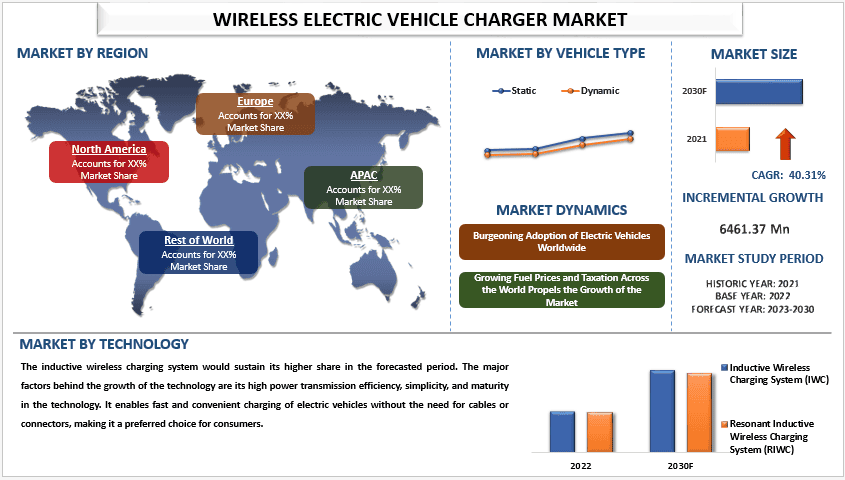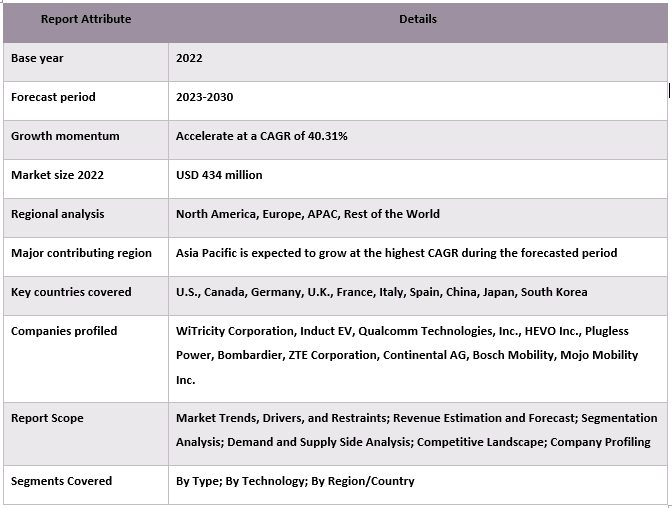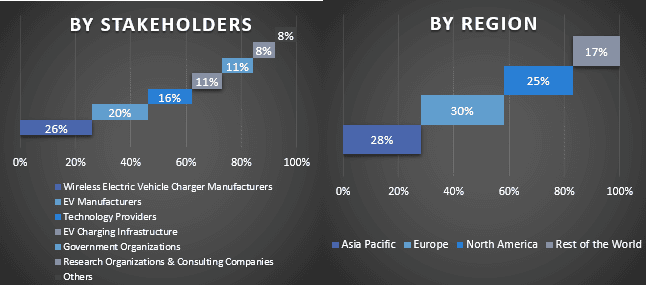- Home
- About Us
- Industry
- Services
- Reading
- Contact Us
Wireless Electric Vehicle Charger Market: Current Analysis and Forecast (2023-2030)
Emphasis on Type (Static and Dynamic); Technology (Inductive Wireless Charging System and Resonant Inductive Wireless Charging System ); and Region/Country

The Wireless Electric Vehicle Charger Market was valued at USD 434.92 million in 2022 & are expected to grow at a CAGR of 40.31% from 2023-2030, Owing to the growing fuel prices all over the world. In today’s era, we all move a little differently through the adoption of electric vehicles due to the increasing fuel prices and the persistent government support to reduce net zero emissions by the target year. The increasing prices of fuel prices make electric vehicles more attractive, as they rely on electricity instead of fossil fuels. Electricity, in many cases, is a more stable and low-cost power supply compared to gasoline or diesel. This affordability component could make an enormous distinction in the operating expenses of electric vehicles, particularly for organizations that have large-scale transportation operations such as Uber, and Ola. Moreover, the implementation of higher taxes on fuel can act as an incentive for the adoption of electric vehicles. These taxes make a contribution to making traditional fuel-powered vehicles more highly-priced to perform, as they directly boost the price of fuel. In contrast, electric vehicles aren’t concerned with those taxes, considering the fact that they make use of strength, which isn’t taxed in the same manner as fossil fuels. This tax benefit could make electric vehicles more economically feasible encouraging them to transition closer to greener alternatives. Therefore, the growing fuel prices and taxation across the world drive the wireless electric vehicle charger market.
Some of the major players operating in the market include WiTricity Corporation, Induct EV, Qualcomm Technologies, Inc., HEVO Inc., Plugless Power, Bombardier, ZTE Corporation, Continental AG, Bosch Mobility, Mojo Mobility Inc. Several M&As along with partnerships have been undertaken by these players to facilitate customers with hi-tech and innovative products/technologies.
Insights Presented in the Report
“Amongst vehicle types, the static segment dominated the market in 2022”
Based on type, the market is segmented into static and dynamic. Among them, Static has a high market share in 2022 and will dominate during the forecast period. This is due to the higher adoption of static as compared to dynamic as well as dynamic segment is still in the development phase for many of the countries. Moreover, static wireless charging is considered safer than dynamic charging as it eliminates the risk of electrical shock and fire hazards associated with moving parts. Static wireless charging is generally cheaper to implement than dynamic charging, primarily due to the absence of complex moving parts and the requirement for smaller power electronics. “Amongst technology, the inductive wireless charging segment highest share in the market in 2022”
Based on technology, the market is segmented into inductive wireless charging systems and resonant inductive wireless charging Systems. Among these, the inductive wireless charging system would sustain its higher share in the forecasted period. The major factors behind the growth of technology are its high-power transmission efficiency, simplicity, and maturity in the technology. It enables fast and convenient charging of electric vehicles without the need for cables or connectors, making it a preferred choice for consumers.
“Asia Pacific expedites highest CAGR for the wireless electric vehicle charger market in 2022.”
The Asia Pacific region would exhibit the highest CAGR during 2023-2030 fueled by a combination of factors that have created a perfect storm of prosperity for this industry. There is a noticeable upsurge in the adoption of electric vehicles (EVs) in the region, primarily due to the increasing awareness regarding environmental sustainability and stringent emission regulations. Countries like China, Japan, South Korea, and India are taking bold steps to promote the usage of EVs, which, in turn, is escalating the demand for efficient and convenient charging solutions like WEVs. Moreover, there is a notable increase in investments and funding allocated towards the development and commercialization of WEV charging technology in the region.
Wireless Electric Vehicle Charger Market Report Coverage

Reasons to buy this report:
- The study includes market sizing and forecasting analysis validated by authenticated key industry experts.
- The report presents a quick review of overall industry performance at one glance.
- The report covers an in-depth analysis of prominent industry peers with a primary focus on key business financials, product portfolios, expansion strategies, and recent developments.
- Detailed examination of drivers, restraints, key trends, and opportunities prevailing in the industry.
- The study comprehensively covers the market across different segments.
- Deep dive regional level analysis of the industry.
Customization Options:
The global wireless electric vehicle charger market can further be customized as per the requirement or any other market segment. Besides this, UMI understands that you may have your own business needs, hence feel free to connect with us to get a report that completely suits your requirements.
Table of Content
Research Methodology for the Wireless Electric Vehicle Charger Market Analysis (2023-2030)
Analyzing the historical market, estimating the current market, and forecasting the future market of the global wireless electric vehicle charger market were the three major steps undertaken to create and analyze the adoption of wireless electric vehicle chargers in major regions globally. Exhaustive secondary research was conducted to collect the historical market numbers and estimate the current market size. Secondly, to validate these insights, numerous findings and assumptions were taken into consideration. Moreover, exhaustive primary interviews were also conducted, with industry experts across the value chain of the global wireless electric vehicle charger market. Post assumption and validation of market numbers through primary interviews, we employed a top-down/bottom-up approach to forecasting the complete market size. Thereafter, market breakdown and data triangulation methods were adopted to estimate and analyze the market size of segments and sub-segments of the industry pertains to. Detailed methodology is explained below:
Analysis of Historical Market Size
Step 1: In-Depth Study of Secondary Sources:
Detail secondary study was conducted to obtain the historical market size of the wireless electric vehicle charger market through company internal sources such as annual reports & financial statements, performance presentations, press releases, etc., and external sources including journals, news & articles, government publications, competitor publications, sector reports, third-party database, and other credible publications.
Step 2: Market Segmentation:
After obtaining the historical market size of the wireless electric vehicle charger market, we conducted a detailed secondary analysis to gather historical market insights and share for different segments & sub-segments for major regions. Major segments are included in the report as type and technology. Further country-level analyses were conducted to evaluate the overall adoption of testing models in that region.
Step 3: Factor Analysis:
After acquiring the historical market size of different segments and sub-segments, we conducted a detailed factor analysis to estimate the current market size of the wireless electric vehicle charger market. Further, we conducted factor analysis using dependent and independent variables such as the type and technology of the wireless electric vehicle charger market. A thorough analysis was conducted for demand and supply-side scenarios considering top partnerships, mergers and acquisitions, business expansion, and product launches in the wireless electric vehicle charger market sector across the globe.
Current Market Size Estimate & Forecast
Current Market Sizing: Based on actionable insights from the above 3 steps, we arrived at the current market size, key players in the global wireless electric vehicle charger market, and market shares of the segments. All the required percentage shares split and market breakdowns were determined using the above-mentioned secondary approach and were verified through primary interviews.
Estimation & Forecasting: For market estimation and forecast, weights were assigned to different factors including drivers & trends, restraints, and opportunities available for the stakeholders. After analyzing these factors, relevant forecasting techniques i.e., the top-down/bottom-up approach were applied to arrive at the market forecast for 2030 for different segments and sub-segments across the major markets globally. The research methodology adopted to estimate the market size encompasses:
- The industry’s market size, in terms of revenue (USD) and the adoption rate of the wireless electric vehicle charger market across the major markets domestically
- All percentage shares, splits, and breakdowns of market segments and sub-segments
- Key players in the global wireless electric vehicle charger market in terms of products offered. Also, the growth strategies adopted by these players to compete in the fast-growing market
Market Size and Share Validation
Primary Research: In-depth interviews were conducted with the Key Opinion Leaders (KOLs) including Top Level Executives (CXO/VPs, Sales Head, Marketing Head, Operational Head, Regional Head, Country Head, etc.) across major regions. Primary research findings were then summarized, and statistical analysis was performed to prove the stated hypothesis. Inputs from primary research were consolidated with secondary findings, hence turning information into actionable insights.
Split of Primary Participants in Different Regions

Market Engineering
The data triangulation technique was employed to complete the overall market estimation and to arrive at precise statistical numbers for each segment and sub-segment of the global wireless electric vehicle charger market. data was split into several segments & sub-segments post studying various parameters and trends in the areas of the vehicle type and technology in the global wireless electric vehicle charger market.
The main objective of the Global Wireless Electric Vehicle Charger Market Study
The current & future market trends of the global wireless electric vehicle charger market were pinpointed in the study. Investors can gain strategic insights to base their discretion for investments on the qualitative and quantitative analysis performed in the study. Current and future market trends determined the overall attractiveness of the market at a regional level, providing a platform for the industrial participant to exploit the untapped market to benefit from a first-mover advantage. Other quantitative goals of the studies include:
- Analyze the current and forecast market size of the wireless electric vehicle charger market in terms of value (USD). Also, analyze the current and forecast market size of different segments and sub-segments
- Segments in the study include areas of the type and technology
- Define and analysis of the regulatory framework for the wireless electric vehicle charger industry
- Analyze the value chain involved with the presence of various intermediaries, along with analyzing customer and competitor behaviors of the industry
- Analyze the current and forecast market size of the wireless electric vehicle charger market for the major region
- Major countries of regions studied in the report include Asia Pacific, Europe, North America, and the Rest of the World
- Company profiles of the wireless electric vehicle charger market and the growth strategies adopted by the market players to sustain in the fast-growing market
- Deep dive regional level analysis of the industry
Related Reports
Customers who bought this item also bought










